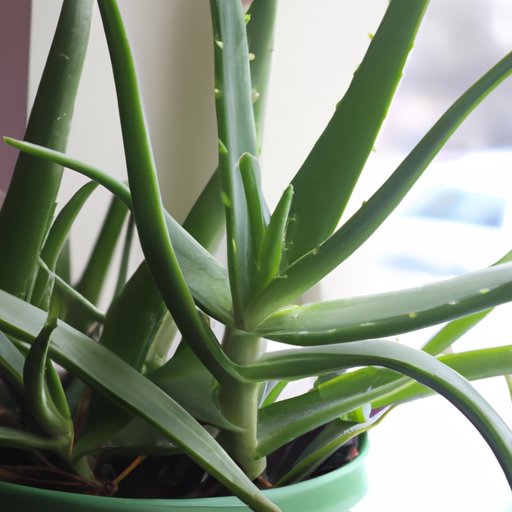
Introduction
Aloe vera plants are versatile, low-maintenance succulents with numerous health benefits. Whether you’re a seasoned plant enthusiast or just starting out, caring for an aloe plant is a great way to add greenery and freshness to your home. In this article, we will provide a complete guide to taking care of your aloe plant, including tips on soil type, watering habits, and sunlight requirements. We’ll also offer advice on how to repot your plant and create an aloe oasis at home.
The Complete Guide to Aloe Vera Plant Care
Choosing the right soil type is crucial to maintaining a healthy aloe vera plant. A mixture of potting soil and sand is best, as it will provide adequate drainage and prevent root rot. Water your aloe plant sparingly and only when the soil has completely dried out. Aloe plants prefer bright, indirect sunlight, so be sure to place your plant near a window or in a well-lit area of your home. If you notice your plant is getting too much sun, move it to a shadier location.
If you need to repot your aloe plant because it has outgrown its container, follow these simple steps. First, remove the plant from its current pot and gently shake off any excess soil. Next, prepare a larger pot with fresh soil and place your plant in the center. Fill in any gaps with additional soil and gently pack down to secure the plant in place. Water your plant thoroughly and let it rest in a shaded area for a few days before returning it to its original location.
5 Simple Ways to Keep Your Aloe Plant Healthy and Beautiful
The container you choose for your aloe plant is very important. Make sure it has adequate drainage holes to allow excess water to escape, preventing root rot. Water your plant once a week in the summer and once every two weeks in the winter. Only water it when the soil is completely dry to the touch. Aloe plants prefer bright, indirect sunlight, so make sure to place them near a window or in a sunny spot. Fertilizing your plant with a cactus or succulent formula once a month can help it grow stronger and healthier. Prune your aloe plant if you notice its leaves are curling or turning brown. Cut off the damaged leaves at the base of the plant using a sharp pair of scissors.
The Do’s and Don’ts of Aloe Vera Plant Care
One of the most common mistakes people make when caring for aloe plants is overwatering. To prevent root rot, avoid watering your plant too often. Another mistake is placing your aloe plant in direct sunlight for extended periods, which can cause sunburn and damage to the leaves. Aloe plants don’t require a lot of water or fertilizer, so be careful not to overdo it. Lastly, never use tap water when watering your aloe plant, as the chlorine and fluoride can damage the leaves. Instead, use filtered or distilled water.
Creating an Aloe Vera Oasis at Home
Aloe plants are not only low-maintenance, but they can also be integrated into home decor. With their tall, spiky leaves and unique texture, they make a great focal point for any room. In addition, aloe plants have numerous health benefits, such as air purification and skin-soothing properties. You can add them to any room in your house, including your bedroom, bathroom, or living room.
Aloes for Beginners
If you’re new to aloe vera plant care, choose a variety that is easy to care for, such as Aloe vera var. chinensis or Aloe vera var. maculata. Before potting your plant, choose a location that receives bright, indirect sunlight and has good air circulation. When potting your aloe plant, make sure the soil is well-draining and prepare a container that is slightly larger than the root ball. To propagate your aloe plant, simply remove a healthy leaf from the base and plant it in fresh soil. Common issues that may arise when caring for aloe plants include overwatering, under-fertilization, and pest infestation.
Conclusion
Caring for an aloe plant is easy and rewarding. By following the tips and tricks outlined in this article, you can ensure that your plant stays happy and healthy. Remember to choose the right soil type, water your plant sparingly, and provide plenty of indirect sunlight. With a little patience and attention, your aloe plant will thrive and add a touch of green to your home decor.




